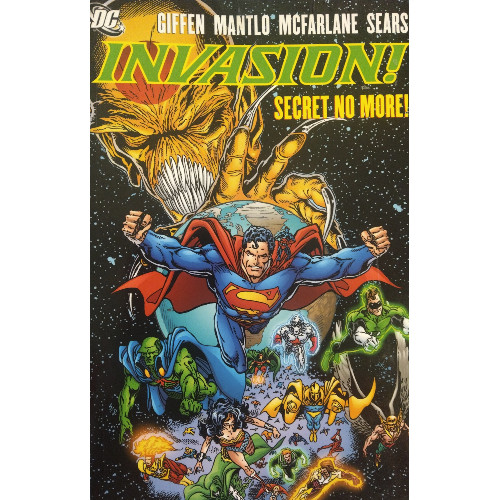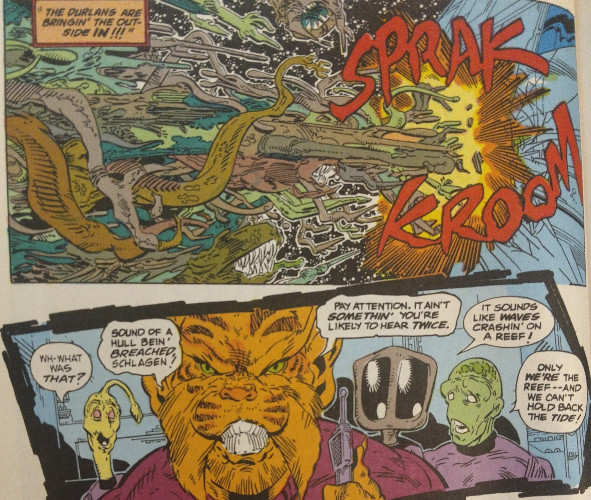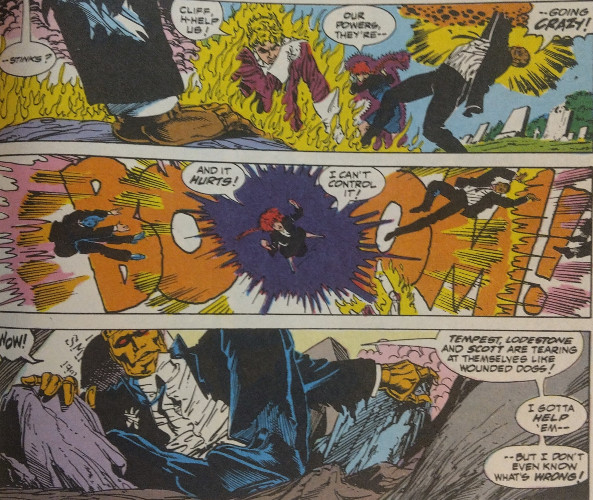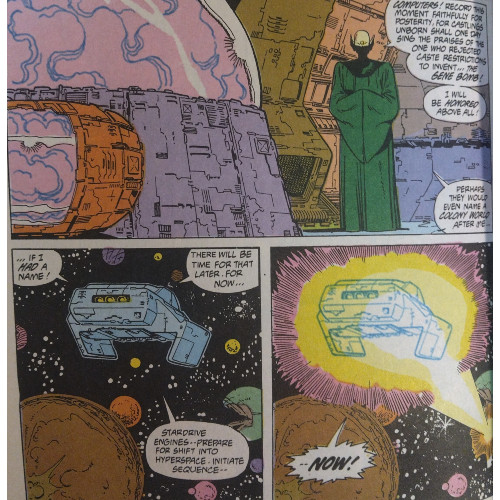Distinguished Critique: Invasion! Review
This crossover fails to find its footing in determining the kind of story it wants to tell, with not enough "invasion" to justify its title
—by Nathan on April 27, 2025—

We once again find ourselves at the feet of another DC crossover extravaganza. It's been a while since I reviewed one of these–I discussed 1988's Millennium back in 2023. There are a myriad of reasons why, but I will detail a particular cause after the intro.
As I continue to work my way through the post-Crisis landscape, I like to occasionally divert from analyzing the stories of individual heroes such as Wonder Woman, Green Lantern, and the Question to focus on these larger arcs. With each crossover, a narrative seems to be simmering, one which helps define the broader face of the post-Crisis DC universe: Earth has become a darker world, maybe matured a little bit, and the status of "heroes as gods" or "heroes as the epitome of human experience" seems a tale of other times. Look no further than DC's first post-Crisis event, Legends, and you'll find a world where trust in heroes is waning. The landscape is shifting. A new Justice League is born, needing to prove itself as a force of light in a world drenched in cynicism. With the new "Millennium" comes a new brand of heroes, new faces for the world to find hope in. Our superhumans (our "legends," if you will) are clawing their way back to the top…and it seems like a little alien invasion is what could push them either onto the summit…or over the edge.
Invasion!
Writers: Keith Giffen and Bill Mantlo
Pencilers: Todd McFarlane, Keith Giffen, Bart Sears
Inkers: P. Craig Russell, Al Gordon, Joe Rubinstein, Todd McFarlane, Tom Christopher, DIck Giordano, Pablos Marcos
Colorists: Carl Gafford and Gene D'Angelo
Letterers: Gaspar Saladino, August Mas, and John Costanza
Issues: Invasion! #1-3
Publication Dates: December 1988-January 1989

I tried reading Invasion! (and, yes, I will be referring to it with the exclamation point each time, so feel free to shout it in your head as you read) twice before finally reaching the end. I've read better comics, but I've also read worse comics, so as I considered this review, I worked to answer the question of why I failed to get through Invasion! (told you) twice.
The answer is fairly simple: the scope outweighs the story.
I complained, in my review on Millennium, that the event was burdened by tie-in issues which practically demanded the reader follow up on ongoing series such as Batman and The Flash to know what was going on, teasing sections of a larger narrative to entice the reader to invest in other titles to understand the full story. Invasion! suffers a similar pathogen, and though a relatively complete narrative is told in the pages, it's also a narrative which struggles against the confines of its three issues. Even though those issues are each 80 pages long, they present a story which could still, amazingly, use additional development.

The solution would not have been to add more issues–this story is already 240 pages long–but to redistribute the narrative told. The first issue ends up being the most interesting of the three, telling the build-up to the titular invasion. We see how the different alien races–Dominators, Khunds, Thanagarians, Gil'Dishpan, Durlans, Warlords of Okaara, Citadelians, Daxamites, and Psions–use their unique physiologies and skills to contribute to the war effort. You'd think pages of plotting and conversation would wind up dull and repetitive, but I felt Giffen and Mantlo justified the space used in developing the invasion plans. We get to see each race as unique, with a couple pages here and there to help us understand how each coalition member contributes, how they think, and what their ultimate aims are. Mantlo and Giffen even provide an early glimpse of the coalition's threat–several aliens decimate spacefaring team the Omega Men; in a sequence lasting several pages, the coalition's scope and menace become very tangible. The pacing works well, slowing the story down for an appropriate period of time to establish the villains' credibility.
It's the other two sections which fall apart upon execution, particularly the middle chapter. Very similar to Millennium, the second Invasion! issue's attention is divided between helping us understand the full scope of the attack on Earth and our heroes' efforts in fending off their alien adversaries. We're given up-close-and-personal viewings of certain battles, including a fight between Superman and the Kryptonian-esque Daxamites, as well as an undersea charge led by Aquaman. But most of the conflicts are glossed over, summations describing how the invasion is faring across the globe. The personal details of each fight, I assume, were left to individual titles to explore more thoroughly across nearly 40 tie-in issues.

You're asked to absorb a lot of information, and like with Millennium, it feels this chapter in Invasion! is responsible for simultaneously progressing the story forward while also promoting other series. Does the image of Animal Man fighting a Thangarian warrior underwater pique your interest? What about Mister Miracle's buddy Oberon defeating a group of miniaturized Khund warriors? Then go check out Animal Man or Justice League International, cause we're not using Invasion! to tell those stories! Giffen and Mantlo lost my interest in the middle of this juggling process, replacing potentially dynamic action sequences with exposition and teases.
As I noted in the introduction, the purpose of this event seems to have been to give our heroes a huge threat to overcome, to reestablish their prominence in the DC Universe following the poisonous machinations of Glorious Godfrey in Legends. That aspect works. Our heroes succeed in driving away the alien hordes. Unfortunately, they do so in a single issue, because the third chapter is involved with a potentially deadly aftermath, one last desperate attempt by a single Dominator to condemn all our heroes to a painful demise. The narrative takes a "race against the clock" vibe as human scientists and heroes work together to discover a solution.

So, yes, there is a coming together of people and superhumans that wraps up this "Can we trust our heroes?" arc that began in Legends. And I think the third issue does that well. The problem, as I see it, is that it's a massive tonal shift from the preceding two issues. Issue #1 geared us up for war, and issue #2 executed the war, but issue #3 takes on this medical procedural feel combined with the frantic race-against-time quality. As a result, the narrative is all over the place. Each chapter retains its own identity, but as a larger arc, the pieces feel haphazardly put together.
Like the second chapter, the scope of this final issue fails its page count. An entire war fought between several races of aliens and multiple superheroes has been told in a single issue, and the highly dramatic fallout is left for an issue of the same length. In this instance, the page count outweighs the driving narrative, scenes constantly shifting between characters to keep the narrative flowing, but the ever-shifting pace doesn't feel necessary. Mantlo and Giffen try to justify this brand new idea tacked on to the end of the invasion, whereas I would argue the best idea would have been to run the invasion longer. Two issues of Earth transformed into a battleground, with a decent denouement at the end. You've got 160 pages here! This could have been told well. Instead, the ever-shifting scenery feels intentional, primarily because (I assume) Mantlo and Giffen needed to stretch the idea to fill the space. The machine gun-fire style of storytelling in the second issue prevented Mantlo and Giffen from diving too deep into the muscle of the invasion; a similar pace is established here, but it feels like a disguise to keep readers from understand there's just not narrative within this superhuman medical drama to capture the attention for 80 pages.

Additionally, Giffen and Mantlo introduce this little controversial concept early on: the existence of the metagene, which the writers use to explain how a smattering of Earthlings gain superpowers. Similar to how certain individuals in the Star Wars universe possess microscopic midi-chlorians to determine their Force sensitivity (is that still a thing in the Disney era of Star Wars?), so do some humans in the DC Universe possess a biological preference for developing superhuman abilities. From the little I have read, the concept was somewhat controversial, exchanging the innate heroism of some characters for a more grounded, physical reason why they acquired powers.
I'm less concerned about the controversy of the concept (especially as the notion doesn't affect the story much until the third chapter) and more interested in the character invested in the metagene idea. A Dominator (noted to be a "minor castling") attempts to isolate this genetic anomaly to prove his worth to his race, and despite doubts from his superiors, manages to play an integral part in the third issue as that "single Dominator" I referenced above. He receives, out of our whole cast, the most characterization, striving against the boundaries imposed on him at birth to make a name for himself as the alien to save the invasion fleet on the brink of total loss. But even then, with this nameless villain popping up throughout the series, his story is largely subsumed by the ongoing events around him, important in the moments he does appear but then lost to the ever-raging conflicts bounding across the pages.

Invasion!, like its predecessor, becomes a victim of its formatting, a narrative with a scope so large that it appears it must be told in 40+ issues of various series to understand its entirety. Streamlining the narrative presented could have done this limited series a wealth of good–each issue feels tonally different from the others, focused on different aspects of a larger narrative. The first two chapters feel more connected than the final issue (which, arguably, could have been told separately as its own story), but the pacing of all three issues feels rushed. Mantlo and Giffen spend too much time jumping between characters and viewpoints to provide a solid narrative that offers the necessary depth for an invasion of this size. I feel we scratch the surface of how the alien coalition scratches the surface of the Earth, leaving devastation and death with very little time to absorb the impact. Yes, our assembled heroes save the day, as they always do, but it comes with a price–a physical price to them but a financial price to any reader who wants to know the full scope of the story.